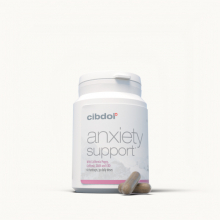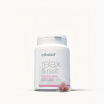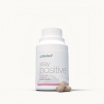How do I train my brain to stop anxiety?
Published:
Anxiety is one of the most common mental health issues, affecting over 284 million people worldwide. While anxiety can be debilitating, the good news is that our brains are malleable and we can train them to be less anxious. In this comprehensive guide, we'll explore evidence-based techniques to train your brain to stop anxiety.
Contents:
- What is Anxiety and How Does it Affect the Brain?
- Train Your Brain by Managing Anxious Thoughts
- Train Your Brain by Managing Anxious Behaviors
- Train Your Brain by Activating the Prefrontal Cortex
- Nutrition and Lifestyle Factors that Fight Anxiety
- When to Seek Professional Help
- Conclusion
- Resources used to write this article

What is Anxiety and How Does it Affect the Brain?
Anxiety is characterized by persistent, excessive worry that is out of proportion to the situation. This chronic state of apprehension leads to physical symptoms like muscle tension, fatigue, restlessness and difficulty concentrating.
At the root of anxiety is hyperactivity in the amygdala, the part of the brain responsible for detecting threats and triggering the body's stress response. When faced with a potential threat, the amygdala activates the sympathetic nervous system, releasing stress hormones like adrenaline and cortisol. This prepares the body to fight or flee.
While this response is useful when faced with immediate physical danger, chronic activation due to abstract worries is problematic. Excessive amounts of stress hormones suppress the prefrontal cortex, the rational, thinking part of the brain. This makes it difficult to regulate emotions, think clearly and make sound decisions.
Fortunately, with consistent training we can dampen our threat response and build up our brain's emotional regulation capacity. The key is to use techniques that calm anxious thoughts and behaviors while activating the prefrontal cortex.
Train Your Brain by Managing Anxious Thoughts
Anxiety often arises from excessive rumination - when our brains get stuck on a loop thinking about potential threats. To combat this tendency, implement thought-management techniques:
Practice Mindfulness
Mindfulness teaches us to stay grounded in the present moment instead of getting carried away by anxious thoughts.
Set aside 5-10 minutes each day to sit quietly and focus on your breath and bodily sensations. When anxious thoughts enter your mind, acknowledge them without judgment and redirect your attention. Over time, this builds awareness and reduces rumination.
Cognitive Restructuring
This technique challenges the distorted thinking patterns underlying anxiety. Ask yourself what evidence supports your worries and try to view situations more objectively. For example, instead of thinking "I'll definitely mess up my speech and be humiliated" try "I've practiced my speech extensively and know the content well. If I stumble over a few words, it won't be catastrophic."
Thought Stopping
When you notice your mind spinning with anxious thoughts, visualize a big STOP sign and redirect your attention to the present moment using your senses. For example, notice five things you can see, four things you can feel, three things you can hear etc. This disrupts the anxious thinking cycle.
Train Your Brain by Managing Anxious Behaviors
In addition to thoughts, we need to manage anxiety-driven behaviors and habits:
Minimize Avoidance
It's natural to avoid anxiety-provoking situations, but this backfires long-term. By facing our fears we realize they are more manageable than anticipated. Gradually step out of your comfort zone to grow more confident.
Reduce Safety Behaviors
Safety behaviors are habits we use to dampen anxiety, like excessively planning, carrying anti-anxiety medication everywhere or staying near exits. Paradoxically, these reinforce anxiety. Minimize your use of safety behaviors and tolerate uncertainty.
Improve Stress Tolerance
Work on handling day-to-day stresses without becoming overwhelmed. For example, practice slowing your breathing when stuck in traffic instead of getting frustrated. This trains your brain to maintain composure under stress.
Train Your Brain by Activating the Prefrontal Cortex
The prefrontal cortex regulates emotions and calms the amygdala's threat response. We can amplify its activity through:
Aerobic Exercise
Aim for 30 minutes of heart-pumping exercise at least 3 times per week. This stimulates neurotransmitter systems that improve prefrontal cortex functioning.
Relaxation Techniques
Try restorative yoga, meditation, deep breathing or progressive muscle relaxation. Activating the body's relaxation response reverses the effects of anxiety.
Cognitive Activities
Tasks like learning a new skill, playing chess or doing crossword puzzles activate and strengthen cognitive control centers in the prefrontal cortex.
Anxiety Workbooks
Structured programs provide step-by-step guidance to understand and overcome anxiety using CBT and mindfulness-based techniques.
Therapy
Speaking with a mental health professional helps build insight into the root of anxiety and develop constructive ways to manage it. This also strengthens the prefrontal cortex.
Nutrition and Lifestyle Factors that Fight Anxiety
Support your brain training by optimizing daily habits:
Reduce Caffeine
High caffeine intake stimulates the central nervous system and can worsen feelings of anxiousness and jitteriness.
Minimize Alcohol
While alcohol might reduce anxiety short-term, it often increases anxiety as it wears off. It also disrupts sleep patterns.
Quit Nicotine
Smoking ramps up the nervous system. Quitting can significantly decrease anxiety levels over time.
Improve Sleep Quality
Not getting 7-9 hours of quality sleep nightly can exacerbate anxiety. Follow good sleep hygiene practices.
Eat a Mediterranean Diet
This diet high in fruits, vegetables, whole grains, fish and olive oil fights inflammation and promotes prefrontal cortex health.
Consider Supplements
Research shows magnesium, omega-3s, lavender oil, chamomile and green tea can mildly decrease anxiety. Discuss options with your doctor.
Reduce Stress
Chronic stress takes a toll on mental health. Make time for relaxing activities like reading, nature walks and social connection.
When to Seek Professional Help
While you can make great progress managing anxiety on your own, seek help from a doctor or mental health professional if anxiety:
- Impacts your daily functioning
- Worsens despite self-help efforts
- Causes suicidal thoughts
- Is accompanied by substance abuse
- Is rooted in an underlying health condition
Medications like SSRIs and mental health services like CBT and exposure therapy can provide immense relief.
Conclusion
Training your brain to stop anxiety requires rewiring thought patterns and habits and increasing prefrontal cortex activity through lifestyle changes and targeted techniques. By managing anxious thoughts, minimizing anxious behaviors, engaging in mindfulness practices, exercising, improving your diet and considering supplements and professional help, you can gain freedom from anxiety's grip and live a more present, joyful life. Implementing even a few of these tips can get you started on the path towards lasting relief.
Resources used to write this article
Anxiety and Depression Association of America. (2022). Facts & Statistics. https://adaa.org/understanding-anxiety/facts-statistics
Hofmann, S. G., Asnaani, A., Vonk, I. J., Sawyer, A. T., & Fang, A. (2012). The Efficacy of Cognitive Behavioral Therapy: A Review of Meta-analyses. Cognitive therapy and research, 36(5), 427–440. https://doi.org/10.1007/s10608-012-9476-1
Kaczkurkin, A. N., & Foa, E. B. (2015). Cognitive-behavioral therapy for anxiety disorders: an update on the empirical evidence. Dialogues in clinical neuroscience, 17(3), 337–346. https://doi.org/10.31887/DCNS.2015.17.3/akaczkurkin
McEwen B.S. (2007). Physiology and neurobiology of stress and adaptation: central role of the brain. Physiological reviews, 87(3), 873–904. https://doi.org/10.1152/physrev.00041.2006
Moreno, F. A., Wiegand, C. B., Taitano, E. K., & Delgado, P. L. (2006). Safety, tolerability, and efficacy of psilocybin in 9 patients with obsessive-compulsive disorder. The Journal of clinical psychiatry, 67(11), 1735–1740. https://doi.org/10.4088/jcp.v67n1110
Prather, A. A., Bogdan, R., & Hariri, A. R. (2013). Impact of sleep quality on amygdala reactivity, negative affect, and perceived stress. Psychosomatic medicine, 75(4), 350–358. https://doi.org/10.1097/PSY.0b013e31828ef15b
Sagliano, L., Trojano, L., Amoriello, K., Migliozzi, M., & D'Olimpio, F. (2019). Attention training reduces anxiety while enhancing executive control performance. Cognitive therapy and research, 43(4), 705-717. https://doi.org/10.1007/s10608-018-09968-2
Wang, C., Pan, R., Wan, X., Tan, Y., Xu, L., Ho, C. S., & Ho, R. C. (2020). Immediate Psychological Responses and Associated Factors during the Initial Stage of the 2019 Coronavirus Disease (COVID-19) Epidemic among the General Population in China. International journal of environmental research and public health, 17(5), 1729. https://doi.org/10.3390/ijerph17051729



















